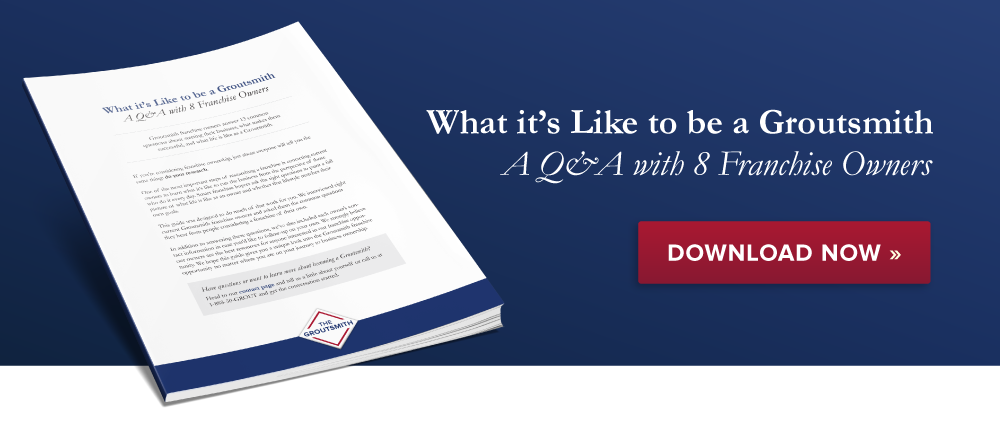Finding a franchise opportunity that’s both low-cost and profitable can be tough. But as any successful franchise owner will tell you, it’s well worth the work to identify a winning opportunity.
If you’ve spent any time looking for low-cost franchises online, you’ve likely seen many businesses that label their franchise opportunity “low-cost.” In truth, it’s easy for a franchise to call themselves low-cost. It’s not always easy for buyers to validate whether or not it’s genuinely any less expensive than other opportunities after considering the potential for a healthy return on investment.
To help you test whether a low-cost franchise has enough potential to make it worth your investment, we’ve asked some of our own franchise owners how they determined that the franchise they ultimately chose was both affordable and positioned for high ROI.
Use the following steps below to evaluate low-cost franchise opportunities for profitability.
1. Run a cash flow analysis based on franchise investment and financing.

To run a cash flow analysis, you’ll first need to know how much the investment is going to cost (to the best of your ability). After you’ve made contact with a franchisor to show interest, request the business’s franchise disclosure document (or FDD). The FDD is an invaluable resource to have as you put together your budget for franchise investment and it must conform to Federal Trade Commission (FTC) guidelines.
Within the FDD, the initial investment for the franchise is covered in detail within Items 5 and 7. Follow up with the franchisor to get any lingering questions answered regarding the investment.
Once you have cost numbers for a franchise opportunity (low-cost or otherwise), you can run an analysis to make sure the cash flow of the business would be able to support your available debt service if you’re financing your investment.
Many franchisors place a limit on the amount of money a franchisee may borrow in making their franchise investment for this very reason.
The best way to do this is to partner with an accountant or another financial advisor to prepare projections for your business to make sure it’s well-positioned for positive cash flow.
If it is, when calculating your ROI, consider that your return should be based on the amount you have contributed to directly, not and on the entire investment. This way, you can actually calculate the cost advantage of a low-cost opportunity versus more expensive options based on how you plan to finance the investment.
Tips for financing your franchise investment
If you’re financing a part or a majority of the investment from your bank or other lending institution, be aware that many franchisees make the process of getting a loan easier by obtaining one guaranteed by the Small Business Administration (SBA).
In fact, the SBA has Franchise Registry specifically for this you can access here.
Years ago, getting a financing a franchise investment involved a tedious review process. Each time you applied for a franchise loan, a local examiner was required to read and evaluate the franchisor’s offering to ensure that it met the SBA’s independence requirements.
Today, franchisors supply their documents to the SBA in advance. Once you’re approved as a franchisee, you no longer have to go through the document review process. This doesn’t guarantee you’ll get a loan, but it makes it much faster and easier if you do.
You can view the full list of franchisors that have been approved on the SBA registry here. Download the list file to ensure any franchisors you’re considering to make sure they’re approved if you’re financing your investment this way.
2. Use franchise cost numbers to forecast potential ROI.

Working with an experienced accountant or another financial advisor, it’s not difficult to project the return on investment you can expect to achieve given different performance variables if you have a few pieces of information at your fingertips:
The Franchise Disclosure Document
Item 19 of the FDD provides the Financial Performance Representation (or FPR).
While not all franchisors provide this, most do. This will give you performance information on the existing franchise locations. Some are very detailed while others offer only statistical information.
When reviewing an FPR, be sure to read and understand any accompanying notes as well. This will help you understand what information the franchisor is using and what may not be included.
The FDD also gives you other useful information, including:
- An approximate initial investment amount (Item 7)
- Initial and continuing fees to the franchisor (Items 5 and 6)
- Information regarding any revenue from merchandise or equipment you purchase for your business (Item 8).
Read our full guide to navigating an FDD here.
Existing and former franchisees
In addition to the financial information in the FDD, you will also find a list of current and former franchisees in Item 20 of the document. Prepare a list of financial questions and reach out to these franchisees to understand the actual costs of investment in the franchise, the financial performance, break-even point, and more.
“Have at least some long-term vision for what you ultimately want out of the business. Determine at the very beginning if you’re going to do the ‘slow and steady wins the race’ or put fuel on the fire and make it explode.”
Nelli Tucker, Groutsmith Franchise Owner since 2013. Get our full franchisee Q&A guide.
Get a list of the key questions to ask existing franchisees here.
Available information about competitors
It’s important to do what competitor research you can about similar types of businesses using information available online.
3. Consider how a low-cost franchise could potentially increase ROI.

To make a workable bottom-line projection about a franchise opportunity, you need reliable information and sensible business judgment. That means resisting any urge to adjust numbers at the top-line in order to make the bottom line better, whether it’s setting unreasonable revenue assumptions, changing the real cost of goods, or underestimating labor costs.
That said, there are a few important qualities of low-cost franchises that not only keep initial costs down but ongoing expenses, too. Failing to account for these can make a financial project look worse than it really is, so it’s important to identify them in any low-cost franchise you consider.
- Is it a home-based franchise? Since many low-cost franchises are home-based businesses, profitability may be achieved more quickly. For example, our Groutsmith franchisees work directly out of their homes and use far less expensive storage spaces to house their equipment, letting them keep or reinvest more of their earnings.
- Does it require hiring employees? Payroll can be a budget-killer, especially early on. Franchises that don’t require you to hire right away (unless you’re ready to) allow you to grow your team along with your business to ensure you can sustain yourself in the short and long term.
- Is training built-in? Training can look very different depending on what industry you’re looking to enter. Make sure a franchise’s training program is accurately covered in your financial forecast. Talk to existing franchisees to see if any additional expenses were needed to become an expert.
In addition to these, consider the general benefits of a low-cost franchise. Since they typically don’t to require much overhead and staff, low-cost franchises may fare better through challenging economic times. This is especially true if they provide essential services like home maintenance or senior and child care.
Scalability is also typically better, too. Without good profit and no debt, you may be able to purchase additional locations or territories.
Final thoughts and next steps
Developing a proper financial projection is an important step in choosing a low-cost franchise opportunity that fits your goals and your budget. While your ability to manage and operate your business is the ultimate determinant of success, you first need an opportunity you can expect to see a return from given your effort to make it work.
The Groutsmith is a low-cost home services franchise built specifically to realize all of the advantages we just covered here. With a low initial franchise fee, minimal overhead, and a sliding royalty fee scale, we help entrepreneurs generate positive cash flow and ROI as quickly as possible.
“We followed [The Groutsmith’s] recommendations right out of the gate. I sent one person to training. Quickly within another week or two, I hired another person and we cash flowed right away. There’s always a ramp-up of revenue and cash flow, but we never had to go into our pockets again. Every year I’ve probably grown this business 15 to 18 percent. We signed on in 2011 and our first full year was 2012 and by this year’s end, we will do a million dollars in revenue, so we’re pleased with that.”
Mike Ketzner, Groutsmith Franchise Owner since 2011. Get our full franchisee Q&A guide.
Interested in learning more about a low-cost franchise opportunity that give you the tools and expertise needed to succeed and grow? Click here to learn more about why The Groutsmith stands above the competition. Want to get started today? Click here to connect with us one-on-one.
Other helpful articles:
- How to Open a Franchise With Little Money
- 7 Questions to Ask Before Buying a Franchise with Your Spouse
- How to Turn a Low-Cost Franchise into a Highly Profitable Business
- 5 Money Questions to Ask Before Buying a Franchise
- 5 Things to do After You’ve Found the Right Franchise
Read a real-life Groutsmith franchise success story:
- Meet Mike Ketzner, Groutsmith owner in Orlando, Florida
- Read What it’s Like to be a Groutsmith: a Q&A with 8 franchise owners
Looking to learn what it’s like to own a Groutsmith franchise? Get a first-hand look from eight franchisees in our free Q&A guide. Click below to download.


